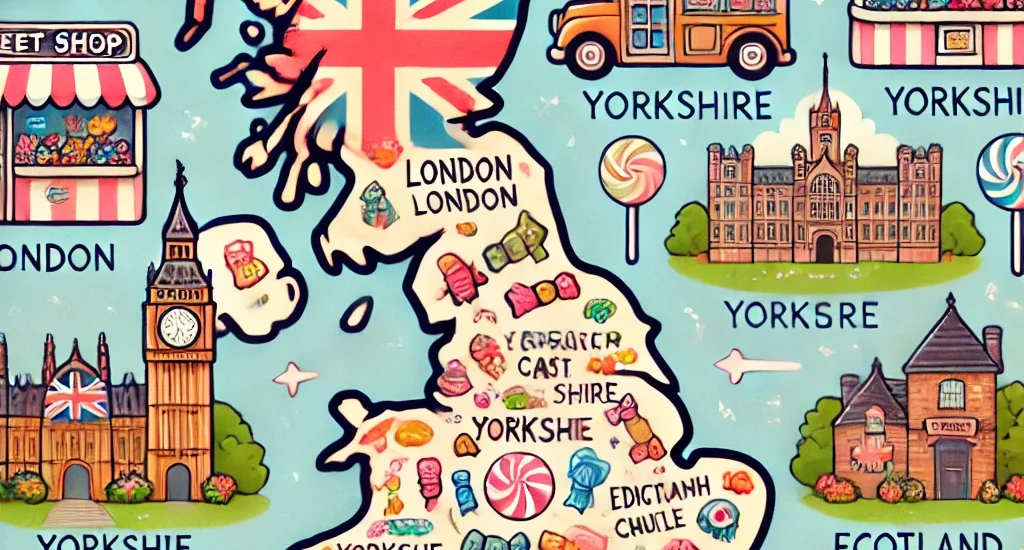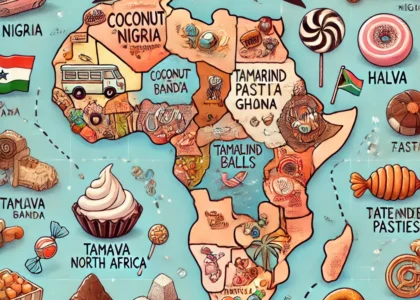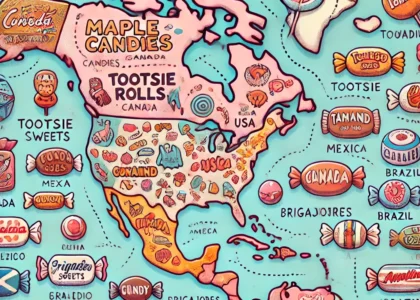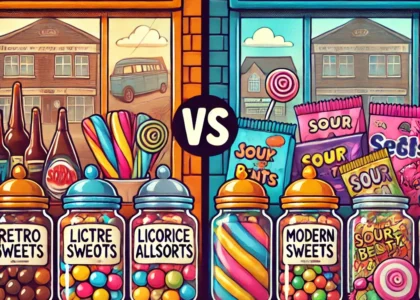Introduction
Retro sweets have long held a place in the hearts of UK consumers, representing both culinary nostalgia and cultural history. Beyond home consumption, the resurgence of interest in retro confectionery has spurred the growth of dedicated sweet shops across the United Kingdom. These establishments not only offer a wide variety of nostalgic sweets from the 1970s, 1980s, and 1990s but also act as cultural hubs, preserving the sensory and social experiences of past generations.
This article explores the regional landscape of retro sweet shops in the UK, highlighting prominent stores, the types of sweets they offer, and the role they play in local communities. In addition, it provides guidance on sourcing sweets, creating themed collections, and understanding the enduring appeal of retro confections in today’s market.
1. Historical Significance of Retro Sweet Shops
1.1 Evolution of Sweet Shops in the UK
The classic UK sweet shop dates back to the 19th century, evolving through the post-war era and the 20th century. By the 1970s, the proliferation of sweets like Fruit Salads, Black Jacks, and Flying Saucers coincided with an era of increased mass production and brand marketing. Small-scale local shops provided access to both everyday treats and regional specialties.
1.2 Cultural Importance
- Community Hubs: Retro sweet shops often served as gathering spaces for children and families.
- Consumer Experience: Pick n mix counters allowed customers to select individual sweets, providing interactive engagement.
- Brand Discovery: Shoppers were introduced to iconic brands like Swizzels Matlow, Barratt, and Taveners.
2. Major Regional Sweet Shops in the UK
2.1 London
London, as a cosmopolitan hub, hosts numerous retro sweet shops that cater to locals and tourists:
- Choccywoccydoodah: Offers curated retro sweets alongside artisanal chocolate.
- Honest Retro Sweets: Features a pick n mix counter with hundreds of options, including rare finds.
- My Retro Sweets – London Outlet: Specialises in decade-themed sweets and hampers.
London’s shops often combine nostalgic candy with themed experiences, making them ideal for party planning or gift shopping.
2.2 Manchester
Manchester is notable for its vibrant sweet shop culture:
- Retro Sweet Shop Manchester: Offers large-scale pick n mix stations and retro chocolate bars.
- Candy Corner: Focuses on 1980s and 1990s sweets, including limited edition releases.
These shops attract both adults seeking nostalgic experiences and families with children, combining retail and social interaction.
2.3 Birmingham
Birmingham’s retro sweet scene emphasizes customisable gift options:
- Sweet Memories Birmingham: Curated hampers featuring retro sweets in jars and boxes.
- Pick n Mix Central: Focused on interactive candy stations, ideal for events and corporate gifts.
The region also offers wholesale options for party planners and businesses seeking bulk orders.
2.4 Leeds
Leeds maintains a thriving community of retro sweet enthusiasts:
- Leeds Sweet Shop: Specialises in sweets from the 1970s and 1980s, with themed packaging and gift boxes.
- The Candy Emporium: Offers rare and seasonal retro sweets, attracting collectors and enthusiasts.
2.5 Glasgow
Glasgow combines historical charm with modern retro retail:
- Glasgow Retro Sweet Shop: Features traditional pick n mix counters alongside curated hampers.
- Vintage Candy Co.: Offers both retail and wholesale options for nostalgic sweets.
Glasgow’s shops are notable for hosting events and tastings, providing an immersive retro candy experience.
2.6 Darlington
Darlington offers a small but dedicated selection of retro sweets:
- Darlington Sweet Shop: Maintains classic confectionery from multiple decades.
- Pick n Mix Darlington: Emphasises interactive customer experience with a wide variety of retro favourites.
These smaller regional shops often preserve rare and local sweets, not found in major urban centres.
3. Types of Retro Sweets Commonly Available
3.1 Chewy Sweets
- Fruit Salads and Black Jacks: Iconic chewy favourites from the 1970s and 1980s.
- Chewy Cola Bottles: Tangy gummies popular in school tuck shops.
3.2 Fizzy and Interactive Sweets
- Dip Dabs and Sherbet Fountains: Interactive sweets that combine taste and play.
- Flying Saucers: Small chalky wafers filled with fizzy sherbet powder.
3.3 Chocolate-Based Sweets
- Retro Chocolate Bars: Cadbury and Barratt editions from various decades.
- Chocolate-Coated Chews: Rare experimental sweets that combine retro flavours with chocolate.
3.4 Rare or Limited Edition Sweets
- Seasonal or region-specific items often found in smaller shops or through online special orders.
4. Planning a Regional Retro Sweet Tour
4.1 Research and Mapping
- Identify target cities or regions with multiple sweet shops.
- Use online directories, Google Maps, and local forums to locate the best options.
4.2 Sampling Strategy
- Prioritise shops with pick n mix counters for a wider sampling of sweets.
- Document flavours, brands, and packaging for reference.
4.3 Budgeting and Logistics
- Estimate cost per sweet or per jar for travel planning.
- Allocate extra budget for rare or limited edition items.
5. Sourcing Sweets for Parties or Collections
Many retro sweet shops offer options for both personal consumption and party planning:
- Pick n Mix Counters: Flexible for creating jars, hampers, or themed collections.
- Gift Boxes and Hampers: Pre-curated options for gifting or special events.
- Wholesale Options: Available in some shops for bulk orders at discounted rates.
Tips for sourcing:
- Ask for special edition sweets not displayed openly.
- Combine local rarities with popular retro favourites for maximum impact.
- Consider online ordering from regional shops to complement in-store purchases.
6. The Social and Cultural Appeal
Retro sweet shops serve as more than just retail outlets:
- Community Engagement: They foster social interactions among children and adults.
- Heritage Preservation: By maintaining classic sweets and packaging, these shops preserve cultural history.
- Educational Value: Displaying sweets by decade teaches younger generations about historical consumption patterns and marketing trends.
7. Health and Dietary Considerations
While retro sweets are indulgent, modern sweet shops increasingly provide options for all dietary needs:
- Sugar-Free Variants: For those monitoring sugar intake.
- Vegan Retro Sweets: Plant-based alternatives of classic candies.
- Allergen Information: Shops clearly label nuts, gluten, and dairy to ensure safe consumption.
8. Case Studies of Notable Regional Shops
8.1 London: My Retro Sweets Outlet
- Features curated decade-specific hampers.
- Hosts in-store events for children’s parties.
8.2 Manchester: Candy Corner
- Offers rare and seasonal sweets.
- Provides DIY pick n mix stations for corporate events.
8.3 Darlington: Pick n Mix Darlington
- Known for interactive counters and personalised sweet jars.
- Maintains a selection of rare retro candies not found in larger cities.
These examples highlight how retro sweet shops combine retail, social engagement, and cultural preservation.
9. Tips for Collectors and Enthusiasts
- Track Regional Variants: Some sweets were only available in specific cities.
- Document Packaging: Keep wrappers and tins for historical and collector value.
- Engage with Communities: Join forums or social media groups dedicated to retro sweets.
- Plan Visits: Weekend visits often coincide with new stock arrivals or seasonal releases.
10. Conclusion
The regional landscape of retro sweet shops in the UK illustrates the enduring appeal of nostalgic confectionery. From London’s bustling retail scene to Darlington’s intimate pick n mix experiences, these stores serve multiple functions: preserving cultural history, providing interactive experiences, and catering to both consumers and collectors. By understanding the offerings, themes, and historical significance of these shops, enthusiasts can fully appreciate the rich heritage of UK retro sweets while planning engaging visits, themed parties, or personal collections.
Retro sweet shops remain vital cultural touchpoints, ensuring that the flavours, textures, and memories of past decades continue to delight present and future generations.





